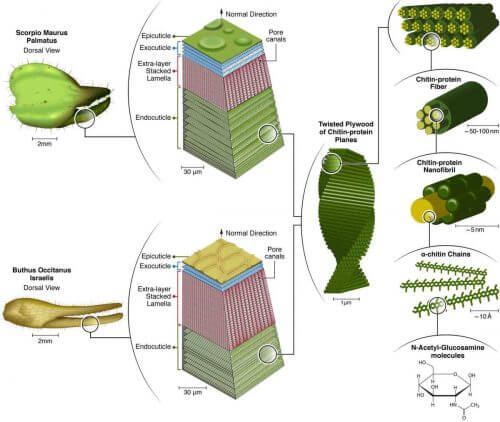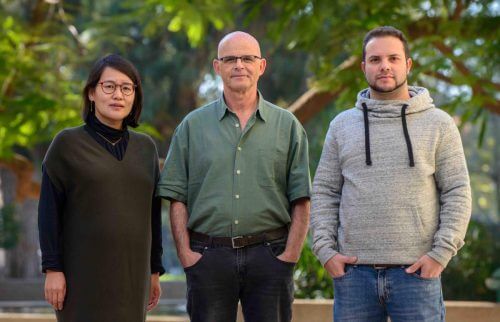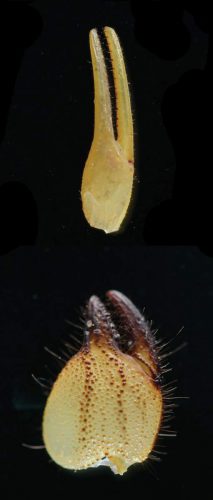A scorpion with thin pincers will prefer to use them to grab hold of its prey for a short moment and immediately sting. A scorpion with thick pincers will use them to crush the prey," explains researcher Israel Kellerstein from the Weizmann Institute.

They have been walking the earth for more than 400 million years. They can be found anywhere in the world and in all climates - except Antarctica. They are solitary cannibals that may devour relatives, and even their offspring, but are able to abstain from food for months, and they glow in the dark (when illuminated with ultraviolet light). Scorpions, from the arthropod family, are invertebrates with an external skeleton known as "cuticle" and a pair of multi-purpose pincers that are used for protection, prey, digging and even courtship and reproduction. Weizmann Institute of Science scientists recently deciphered the multi-layered hierarchical structure of the exoskeleton of the scorpion's pincers - from the nanometer to the millimeter level. This sophisticated structure, which allows scorpions to survive in extremely difficult conditions, may serve as an inspiration in planning and designing new composite materials for human benefit.
From turtle armor and elk antlers to plant seed pods, Prof. Daniel Wagner's research group from the Department of Materials and Surfaces investigates structures that developed in nature and were perfected over millions of years of evolution. This, with the intention of harnessing the "wisdom of nature" to improve many man-made devices - from airplanes and robots to windsurfers and water-resistant clothing. Thanks to its versatility, the arthropod exoskeleton has become a significant research topic in the field of nature-inspired materials development. "Many studies in recent years have been devoted to the structure of the cuticle of crabs and lobsters. The cuticle of the scorpion's pincers is built to cope with various types of efforts - from protection from the elements to digging burrows in the ground, but has received much less research attention," say research student Israel Kellerstein and staff scientist Dr. Xiaomeng Sui from Prof. Wagner's group.

Although there are hundreds of varieties of scorpions, their body structure is remarkably similar everywhere - on the beach and in the forest, in the mountains and in the desert - except for one change: the size of the pincers. The differences in the size of placements give rise to significant differences in behavior. "A scorpion with thin pincers will prefer to use them to hold its prey for a short moment and immediately sting. A scorpion with thick pincers will use them to crush the prey," explains Kellerstein. "Thick tongs are also used for protection - for example for digging alcoves in the ground and blocking them." With the assistance of the Nature and Parks Authority and the Dokifat Center for Ornithology and Ecology in Yeruham, Kellerstein collected from the Sde Boker area mature scorpions that differ in the size of their pincers - a yellow hand scorpion (Scorpio Maurus Palmatus), which is as it is called, and an Israeli scorpion (Israelis Occitanus Buthus), which has thin pincers more, with the aim of understanding the relationship between the structure of the cuticle in the pincers and their function and mechanical properties.

The scorpion's pincers, whether they are thick or thin, consist of a stationary shank (tibia) and a mobile "finger" (tarsus). Similar to other arthropods, their cuticle is made of a composite material of chitin fibers bound together in a hardened protein material combined with metal ions. However, the hierarchical structure of the scorpion's skeleton is much more complex than that of other pincers: the researchers discovered that the cuticle of pincers has eight hierarchical levels - and the second hierarchical level is divided into four sub-layers, as opposed to only three in lobsters and crabs. The outermost layer at this level is the epicuticle - a layer only hundreds of nanometers thick, which has no chitin fibers and does not contribute anything mechanically; The next layer, the exocuticle, consists of four sub-layers in the scorpion with the thick setae (about 20 microns thick) and only two layers in the scorpion with the thin setae (about ten microns thick); Then appears the layer whose place is absent in other pincers: a layer consisting of vertical thin plates (lamellae), which in turn are composed of layers of discontinuous chitin fibers with uniform directionality; And finally the endocuticle - the innermost layer built in a "bouligand" structure: a stack of layers placed on top of each other at an angle so that a spiral is formed that rotates 180 degrees around an axis. In the case of the thick-pinned scorpion, the sublayers in the endocuticle gradually thicken, while in its thinner cousin, they alternately thicken and thicken.
Deciphering the sophisticated structure of the exoskeleton in both species of scorpions revealed that the cuticle of the thin pincers is built for speed rather than strength - and therefore allows the scorpion to quickly and precisely capture small and fast prey, while the thick pincers are stronger than speed - and therefore provide better protection for the thick pincer scorpion. "From the level of the single fiber to the level that is visible - each level in the hierarchical structure of the cuticle has unique mechanical properties which together enable versatility", Klerstein summarizes the findings. Later, the scientists will measure the mechanical properties also at the macro level of the cuticle to understand its resistance to different loads. These measurements, along with deciphering the structure, will make it possible to prepare a synthetic composite material with improved mechanical capabilities inspired by the scorpion's cuticle.
